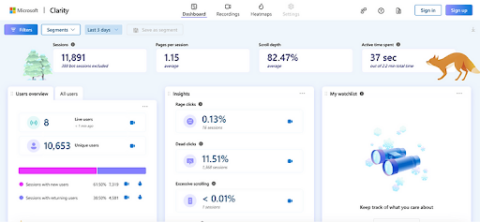This post was sponsored by Wix Studio. The opinions expressed in this article are the sponsor’s own.
Black Friday 2024 is rapidly approaching and with ecommerce websites vying for the attention of a global audience, you’ll need to stand out. Now is the time to put the finishing touches on your SEO implementation, verify your tests and ensure you’ve taken steps to prepare for multi funnel campaigns and traffic.
Your final audit and updates can make the difference between a campaign that goes up and to the right, or falls flat. On Tuesday, October 29, Loren Baker, Crystal Carter and Mordy Oberstein will carry out live ecommerce website audits and share top tips on how to improve your online store.
Image from Wix Studio, October 2024
Want to get a head start?
Here are 7 essential areas to audit now to ensure your site stands out during Black Friday and Cyber Monday (BFCM) 2024.
1. M-Commerce Readiness
It will come as no surprise that your customers will be accessing your site via mobile during Black Friday but in 2024 they should be high priority users in terms of traffic and conversion.
Research shows that retail m-commerce sales in the United States exceeded 491 billion U.S. dollars in 2023 and are expected to drive around 53% of online sales in 2024, up from 51% in 2023.
Optimizing for capturing and converting traffic from mobile users can include a few tried and tested methods.
- Prioritize your site for mobile users by emphasizing above the fold CTAs and trackable events for multi-funnel campaigns.
- Optimize your site for rich results with targeted structured data which can help you capture mobile users more consistently from the mobile SERP.
- Test responsive designs to ensure they are working seamlessly.
- Review mobile navigation from top BFCM landing pages to ensure a smooth customer journey.
2. Server Preparedness
If you are running high traffic campaigns via email, social and paid traffic, it is important to ensure that your website infrastructure is ready for traffic surges. Without proper server preparation, even the most impressive campaign can fail if your site crashes, leaving engaged users unable to convert.
Cloud hosting can offer incredible benefits for infrastructure reliability. For instance, Wix Studio users are able to serve their content across a network with 99.98% uptime with servers that include the AWS, Google Cloud, Fastly and Wix Studio servers on over 200 nodes across the globe.

Screenshot from Wix Studio, October 2024
If you are planning for a huge surge in traffic compared to your typical numbers, review your server configuration to ensure that you can manage the swell.
3. Tested Results
BFCM season is not the time to work on assumptions. Use data and test your content and campaigns. Whether you are split testing landing pages, A/B Testing meta tags, or testing site wide SEO updates, small changes can make a big difference to your year on year growth. Conduct SEO tests with tools like Microsoft Clarity now and review any key findings from previous campaigns to make sure you’re putting the best site forward for peak season.

Screenshot from Wix Studio, October 2024
4. Global Accessibility
Expanding your serviceable market is one of the most effective ways to grow your website and overall business.
Review landing pages, payment offerings, and the on-page positioning of your distribution to connect with a more global audience.
Cross-border ecommerce has grown substantially in the last decade with estimates putting the value of B2C cross border online sales in at $785 billion worldwide in 2021. This means that more users than ever before have the potential to make purchases from countries outside of your core market. Knowing that you offer “worldwide shipping” can help users to convert.
To prepare for traffic from global users:
- Review international SEO implementation.
- Confirm that your payment portals and currencies can support your target markets.
- Localize translated campaign landing pages and copy for maximum impact and value.
- Update T&Cs to reflect additional payment portals and other logistical partners – this can form part of your website’s EEAT profile for ecommerce.
- Update on-page SEO and CTAs to reflect global shipping and delivery options.
5. AI QA for On-Page Seasonal Updates
AI provides powerful capabilities for generating content at scale and will play a crucial role in BFCM 2024 – it’s already everywhere.
Platforms like Wix Studio have built in AI product descriptions, Google Merchant Center have introduced AI product image enhancers, and Amazon Sellers can use AI to help enhance their listing. In daily use, AI offers significant efficiencies, and adapting product descriptions for seasonality is one ideal application. However, it’s crucial to maintain content quality throughout the process.
Audit your AI generated product copy to ensure that your copy is distinct and helpful to users. Product pages should have unique copy and product descriptions should accurately reflect the product being sold. When generating at scale, the auditing process becomes particularly crucial.
6. Google Merchant Feed Status
Google is prioritizing Shopping results in the SERPs, and with over 30 updates to Google Merchant Center, an optimized product feed is key for visibility. Improving the quality of your feed, the product attributes, and identifiers can make a significant difference to the impact of your results for paid and organic search. Changes to product rich results, product categories, and Google Merchant Center can impact what should be featured and highlighted within the product feed. It is worth taking a moment to review your key product listings to ensure they present the most effective information ahead of the big Q4 push.
Review your feed to:
- Remove out-of-season, out-of-stock or low margin products.
- Align with the latest guidelines for required product attributes for your inventory.
- Update structured data to support and/or supplement product feed data.
- Address any invalid products listings.
7. Marketplace Listings Optimizations
As major retailers increasingly adopt the marketplace model to feature third-party products, consumers have come to expect brands to offer a diverse range of items from external sellers.
While the marketplaces have been adopted by high profile online retailers like Walmart, ASOS, and other major players, this option is not limited only to enterprise level teams. Integration and apps make it easier than ever to sell your products on new markets and list others on your site to fill product gaps.
If you are listing content from third-party sellers on your website, you should audit this content for accuracy and ensure that the product description is optimized to a similar standard of your own product listings. This is important for building trust with your users and for showcasing the product in the best light.
For sellers listing on marketplaces, consistency of imagery can help users discover more about your product via visual search. This means that the quality of your product imagery should play a role in part of your listings audits. As well as ensuring compatibility with marketplace requirements, review copy for key products to include keywords, USPs and relevant attributes.
Want to learn more about how you can improve your site for ecommerce? Join the webinar on Tuesday, October 29.
Image Credits
Featured Image: Image by Shutterstock. Used with permission.
In-Post Images: Images by Wix Studio. Used with permission.

